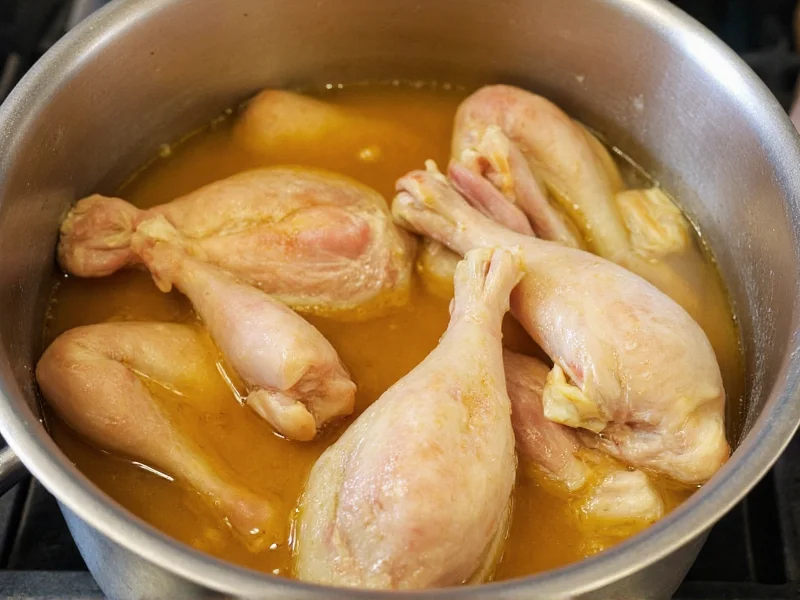When preparing chicken soup, the boiling technique significantly impacts both meat texture and broth quality. Many home cooks make the critical mistake of vigorously boiling chicken, which causes proteins to contract violently, squeezing out moisture and creating tough, rubbery meat. The optimal approach involves gentle simmering that extracts flavor without compromising texture.
Why Simmering Beats Boiling for Chicken Soup
The difference between boiling and simmering chicken for soup isn't just semantic—it's a fundamental culinary principle. True boiling (212°F/100°C) creates violent bubbling that agitates chicken proteins, while simmering (180-205°F/82-96°C) maintains gentle movement that slowly extracts collagen into gelatin without damaging muscle fibers. This temperature control is the secret to achieving fork-tender chicken and clear broth.
Selecting the Right Chicken Cut
Your choice of chicken directly affects both cooking time and flavor development:
| Chicken Cut | Best For | Simmering Time | Broth Quality |
|---|---|---|---|
| Bone-in thighs | Rustic soups | 35-45 minutes | Rich, deep flavor |
| Bone-in breasts | Balanced texture | 25-35 minutes | Moderate richness |
| Boneless breasts | Quick preparations | 15-20 minutes | Milder flavor |
| Whole chicken parts | Traditional stocks | 60-90 minutes | Most complex flavor |
Step-by-Step Boiling Process
Preparation
Always start with cold water—never add chicken to already boiling liquid. Place chicken in pot and cover with cold water by 1-2 inches. Adding aromatics like onion quarters, celery stalks, and bay leaves at this stage enhances flavor without overpowering. For clearer broth, include 1 tablespoon of vinegar to help extract minerals from bones.
Heating Phase
Bring the pot to a gentle simmer over medium heat, watching carefully for the first signs of bubbles breaking the surface. This gradual temperature increase allows impurities to coagulate at the surface where they can be easily skimmed. Skim foam aggressively during the first 10 minutes using a fine mesh skimmer.
Simmering Stage
Once simmering begins, reduce heat to maintain just 1-2 bubbles per second rising to the surface. For bone-in pieces, simmer 20-45 minutes depending on size; boneless breasts need only 12-18 minutes. Use an instant-read thermometer to verify internal temperature reaches 165°F (74°C) at the thickest part.
Proper Handling After Cooking
Immediately transfer cooked chicken to a clean cutting board—leaving it in hot liquid continues cooking and causes dryness. Let rest 5 minutes before shredding with two forks. For cleaner separation, chill chicken in ice water bath for 2 minutes before handling. Reserve at least 4 cups of broth for your soup base, straining through cheesecloth for crystal-clear results.
Common Mistakes to Avoid
- Overboiling - Vigorous boiling creates tough meat and cloudy broth
- Skipping the skim - Neglecting to remove foam results in murky soup
- Overcooking - Chicken continues cooking off-heat; remove at 160°F (71°C)
- Using hot water start - Causes uneven cooking and poor flavor extraction
- Adding salt too early - Can make broth taste metallic; add after cooking
Broth Enhancement Techniques
For restaurant-quality results when boiling chicken for soup, implement these professional techniques:
- Roast bones first for deeper flavor complexity
- Add parmesan rind during last 20 minutes of simmering
- Include 1 teaspoon of tomato paste to balance acidity
- Finish with fresh herbs like thyme or parsley stems
Remember that properly boiled chicken should separate easily with forks but maintain structure—if it's falling apart, you've overcooked it. The broth should have a light golden color with visible gelatin strands when chilled, indicating successful collagen extraction.
Storage and Safety Guidelines
Cool broth within 2 hours of cooking by placing pot in ice water bath. Store chicken and broth separately in airtight containers: broth keeps 4 days refrigerated or 6 months frozen, while cooked chicken lasts 3-4 days refrigerated. Always reheat broth to 165°F (74°C) before serving. Never reuse broth that's been at room temperature longer than 2 hours.
How long should I boil chicken breasts for soup?
Boneless chicken breasts require 12-18 minutes of gentle simmering after the water reaches 180°F (82°C). Bone-in breasts need 25-35 minutes. Always check internal temperature—chicken is done at 165°F (74°C). Overcooking leads to dry, stringy meat unsuitable for soup.
Can I use the same water for boiling chicken and making soup?
Yes, the simmering liquid becomes your broth base. However, for clearer soup, skim foam thoroughly during first 10 minutes and avoid vigorous boiling. Strain the broth through cheesecloth before adding vegetables to maintain clarity and remove impurities.
Why does my boiled chicken become tough in soup?
Chicken becomes tough when boiled vigorously instead of simmered gently. True boiling (212°F/100°C) causes proteins to contract violently, squeezing out moisture. Maintain 180-205°F (82-96°C) with just occasional surface bubbles for tender results. Overcooking beyond 165°F (74°C) internal temperature also causes toughness.
Should I boil chicken before adding to soup or cook it directly in soup?
For best results, boil chicken separately first, then add to soup. This allows precise temperature control for perfect chicken texture and prevents overcooking when adding vegetables later. The reserved broth becomes your soup base. Adding raw chicken directly to soup often results in either undercooked chicken or overcooked vegetables.
How do I prevent boiled chicken from drying out in soup?
Prevent dryness by removing chicken at 160°F (71°C) internal temperature—it will carry over to 165°F (74°C) off-heat. Immediately transfer to a clean surface and let rest 5 minutes before shredding. Never leave chicken in hot broth after cooking. For extra moisture, briefly chill in ice water before handling for cleaner shredding.











 浙公网安备
33010002000092号
浙公网安备
33010002000092号 浙B2-20120091-4
浙B2-20120091-4